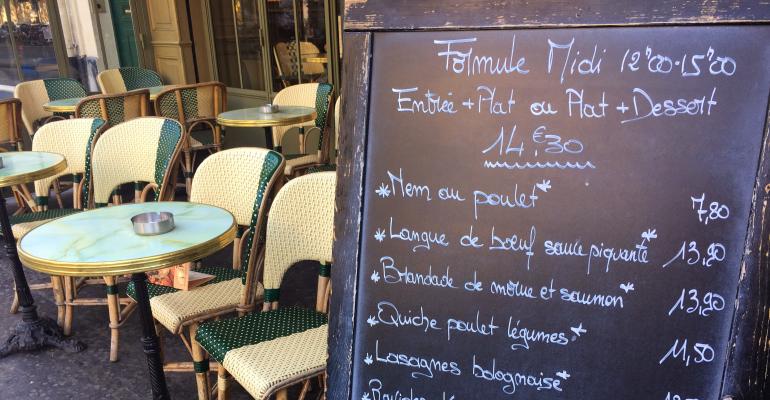Operators are doing fresh takes on menus, ingredients, and trends this year, however some things remain the same.
For example, prices for ingredients and services keep going up, adding an extra burden to many independent restaurants. In fact, based on Nation's Restaurant News' recent report on state of independent restaurants, 58% of respondents said food cost inflation remains a major concern, with supply chain issues falling right behind it. Both affect how chefs put together menus.
For Scott Franqueza, executive chef at High Hampton in Cashiers, N.C., his biggest problem remains the supply chain, where hiccups can turn into real headaches.
"Currently there is a salt crises and you can't get Diamond Crystal Kosher salt, and if someone has it I'm like, 'lock me down for three cases,'" said the chef, adding that price has nothing to do with it; it's all about availability. "The one week we didn't have it I found trying to source another salt was difficult because cooking salt is as intimate to a chef as your knife."
Cost, too, remains an issue, and not just for ingredients, but also labor and transportation. To counteract some of those costs and unavailable ingredients, chefs are looking toward vegetables. They’re dropping the heavy proteins classically featured as entrées or large-format servings in favor of lighter, cheaper fare, all without sacrificing flavor.
"I think with this new year there will be less protein and more vegetables and a focus on vegetarian entrees," said Thach Tran, chef de cuisine of Thompson Denver and Chez Maggie, as well as co-owner of Energy Bar Cafe and T&T Consulting, which he runs in Denver with his husband Dusty Tran. "Before the menu was about 10% to15% vegetarian. Now we're shooting for the 30s because we see more people ordering veggie entrées and side dishes."
Plus, he added, he is excited to get more creative with vegetables, including produce selections. Chef Paul Qui also sees vegetables taking a star role. Qui runs numerous restaurants in Texas, Colorado, and Florida, including East Side King and Thai Kun in Austin, Pao in Miami, and the tasting menu restaurant Koko Ni in Denver, which, he said, the menu gets engineered to fit the cost.
"Overall, I try to minimize large-format meat, whether it's a whole chicken or whole fish," he said. "From a cost perspective it's smarter, and from a diner perspective it tastes better."
Another finding from the study showed that, while having a signature item remains constant for independent restaurants, those dishes don't often translate to a high profit margin. Instead, they help with brand identity and add to the public interest, attracting repeat visitors and hits on social media. Of the restaurants surveyed, 71% said they carry a signature item.
Franqueza is part of the other 29%. His seasonal and ever-fluctuating menu at the North Carolina resort means there aren't signature dishes, and he said that works well for the secluded property. Qui showcases plenty of staple menu items at most of his restaurants, but like Franqueza, his Koko Ni in Denver plays with the season and what's fresh of preserved and available. With Tran's work, signature is key and he works with menu standards at Chez Maggie, which is inside a hotel, and his cafe, which serves healthy, mostly hand-held foods to go.
Tran's fast-causal model follows one of the biggest menu trends right now. According to the report, which surveyed 300 businesses, 54% of independent restaurant operators spend the most time innovating handheld entrées such as burgers, sandwiches, and burritos. Center-of-the plate entrées are a favorite of chefs who want to showcase their skills, but only 29% of operators said such dishes were especially profitable.
Innovation is less of a priority for salads, side dishes, breakfast items, and non-alcoholic drinks.
Asked to select three categories where the most time was spent in product development, all of those categories fell below 30%.
As is often the case, alcohol got cited the most for profitability, garnering 48% of all operators. Appetizers and handheld entrées followed close behind at 41% and 39%, respectively. Breakfast items, at 22% and non-alcoholic drinks, at 28%, scored surprisingly low.
But numbers don't necessarily dictate menu innovation and current trends. Franqueza sees comfort foods stepping into the spotlight. The menu items served in his three-meal-a-day restaurant on the resort may fit in this category, but they’re elevated to match the atmosphere. He said the star of his show are the deviled eggs topped with fried chicken skin and caviar.
"These are not your grandma's deviled eggs, but actually, the recipe comes from my wife's grandma," joked the chef. "I was like, how do we make it over the top and fit in with fine dining?"
In Denver, Tran has been working out ways to add color to classic French comfort food, especially with dessert. For his cafe, he noticed more and more people shy away from dairy so he's embracing that culture and getting rid of it, which he said also helps him manage cost. But overall, he said menu innovation goes back to those vegetables.
"Cauliflower had a spotlight that faded. I'm not sure why," he said. "Honestly, it's hard, I am always trying to find the next Brussels sprout."
With the push to secure the supply chain with local foods and lower, the next haute vegetable may be just around the corner, ready for chefs to play with and find numerous ways to highlight it on menus.
Check out more from this package here:
How restaurant operators balance food costs and pricing amid inflation
Hiring and retaining back-of-the-house restaurant staff remain key challenges for operators
How independent restaurant operators can improve their marketing





